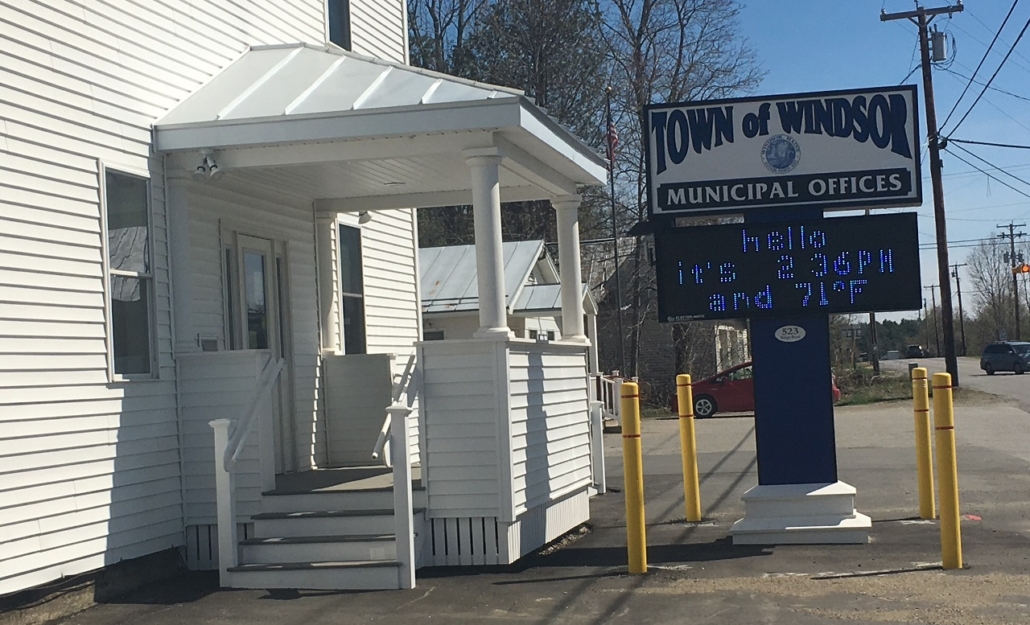Up and Down the Kennebec Valley: Windsor Primary Schools
 by Mary Grow
by Mary Grow
Note: part of this article was first published in the Oct. 28, 2021, issue of The Town Line.
This subseries on central Kennebec Valley towns’ early schools still has one town to cover: Windsor, a few miles off the river, east of Augusta and south of Vassalboro and China.
The area was first settled in the 1780s, mostly by people moving inland from Bristol and Damariscotta via the Sheepscot River. Organized around 1790 as New Waterford Plantation, it became Malta on March 3, 1809, Gerry in 1820 and Windsor in 1822.
Henry Kingsbury, in his 1892 Kennebec County history, commented that the town grew fast. He wrote that “a continual influx of population…augmented by the development of a new generation” meant that within 30 years after the first land claims, “nearly all the valuable lands [were] in the hands of permanent proprietors.”
Kingsbury noted how many of the first settlers’ families stayed in Windsor. His chapter on the town is full of references to their children and grandchildren (mostly the sons) still living there in 1892.
Windsor residents are fortunate: Kingsbury’s book is supplemented and updated by a well-researched town history by Linwood H. Lowden, published in 1993. It includes an equally well-researched chapter on schools by C. Arlene Barton Gilbert.
Gilbert wrote that Rev. Job Chadwick taught the first recorded school in Windsor, in 1804, for two months, with average attendance 15 to 20 students.
Chadwick’s school was funded by the Society for the Propagation of the Gospel, not by taxpayers. Gilbert commented that other religious organizations sometimes funded early education.
The earliest record of a Windsor – Malta, at the time – town meeting that Lowden found was on April 3, 1809, at Rev. Chadwick’s house. Gilbert said voters elected a four-man school committee, John Arnold, John Bughee (Bugbee?), Walter Dockendorff and Thomas LeBallister, and approved a $50 appropriation for education.
Voters also appropriated $700 “to be wrought upon the road or highways.” The latter was supplemented by approval of paying $1 a day for a man’s work on the roads and 66 cents a day for oxen, Lowden reported.
A year later, voters approved five school districts and appropriated $150. Gilbert copied from the town records: “this money for schooling be paid in lumber and produce.” In April 1811, she wrote, they appropriated $200 – and “were already rearranging school districts which they had established two years earlier.”
Kingsbury agreed about the five Malta school districts in 1810, taking information from “[t]he earliest authentic record which has been preserved.” He added, though, that talking with older residents led him to “infer” an earlier division into two or three districts.
One of the first districts, Kingsbury said, covered the entire area east of the West Branch of the Sheepscot River (somewhat less than half the town), and was later (in 1810?) divided into three districts. That district had a schoolhouse “built of logs” close to Charles Mason’s 1892 house.
Voters on April 16, 1812, elected seven school agents (including LeBallister), which Gilbert took to mean there were by then seven school districts. In 1813, she said, no education money was appropriated; but in 1814, one meeting raised $150 and a later one $200. Voters at the second meeting elected eight committee members (including Dockendorff), implying eight districts.
On April 6, 1818, another assemblage of voters approved $500 for education and elected 18 committee members (again including Dockendorff).
As in other towns, a school did not necessarily mean a schoolhouse. Neither Gilbert nor Kingsbury is clear about what Windsor school buildings were where at what time.
Gilbert quoted from a letter an early resident named John Linn wrote in March 1807 to a Boston resident saying he and friends had accumulated supplies to build “a small meeting house and to keep school, but all lies dead now.” What went wrong, and what Linn hoped his Boston friend could do about it, remained unexplained.
Lowden said Linn and his wife Rebecca (Anderson) came to Windsor in 1801 to settle on a lot he bought from his brother-in-law the previous autumn. With them were their 10 children, several of the boys “close to adulthood” (no wonder Linn was interested in a school). The family sailed from Boston to Bristol and “walked most of the way from Bristol to Windsor” (36 miles by 21st century roads).
The log schoolhouse in one of Kingsbury’s inferred pre-1810 school districts was not the first Windsor schoolhouse, he said; the first one was built at Windsor Corner (the present junction of Routes 32 and 105) “about where the town house now stands.” He gave no construction date, but said it burned in February 1832.
Another early schoolhouse Kingsbury called the Center schoolhouse. This building, he said, was used for the annual town meeting in 1819, for the first time.
Lowden said the first proposal to build a town house, where town meetings could be held, was in the spring of 1811; voters rejected it. Until 1819, per Kingsbury, meetings had been in private houses; for five years after 1819, the Center school and the Methodist church shared the duty.
(After that, Kingsbury said, voters assembled in barns. On May 15, 1845, he and Lowden wrote, voters approved building a town house, to be ready by June 1846; they started using it May 21, 1846 [Lowden] or in 1847 [Kingsbury].)
Gilbert wrote that once there were school buildings, annual town meetings – but, she implied, not necessarily special meetings – were “usually” held in them. One exception was on April 2, 1821, when voters met in the District 1 (Windsor Corner) schoolhouse. They raised $100 for education (and $1,200 for roads) and elected a four-man committee “for the inspection of teachers and schools.”
Gilbert summarized the next couple decades, as voters elected town school committees plus a changing number of (unpaid, she said) district agents. Annual education appropriations slowly increased, from $400 to $500 in the 1820s, to $600 in the 1830s and to $700 in 1841.
Kingsbury and Gilbert agreed that Windsor’s first annual school report was printed in 1851. Voters directed town officials to have 350 copies of the report “distributed two days before the annual meeting.” Gilbert did not know of any surviving in 1993.
Windsor’s 15 districts in 1866-67 Gilbert called the largest number simultaneously operating in the town’s history. She quoted at length from the school committee’s district-by-district report (omitting Districts 11, 12, and 15).
On April 1, 1866, the report said, Windsor had 478 students. Two dozen school terms were taught (two terms a year in all but Districts 5 and 6, which had no summer term), by 19 women and five men, funded by $1,161 in town money and $37.86 from the State of Maine.
Committee members (Orren Tyler, C. A. Pierce and Horace Colburn) praised most of the teachers. In District 13, though, it took a while to find the right one. Adelia Cunningham started, but residents were displeased because she wasn’t qualified to teach algebra, and she left after a week. Dolly Hilt, from China, took over; she got homesick and left after five days. Jennie Maxwell was then hired and did a good job.
The 1866 Windsor school committee members were very unhappy with the condition of the school buildings.
“Three-fifths of our school houses are not fit places for schools,” they wrote. Pig-pens or hen-houses, maybe; they refused to label them stables, calling them “miserable huts” and claiming parents who sent their children into them wouldn’t consider housing their horses or oxen so badly over the winter.
One consequence, the school committee members said, was that competent teachers refused to teach in Windsor, and the town had to hire inferior ones.
Their proposed remedy was consolidation, among small districts or between a large and a small, to provide resources to build decent buildings. It would be better, they said, for children who wanted an education to travel a mile and a half to a school “that will fully repay them for their labor” than to go half a mile “and attend a nuisance.”
In 1878/79, school supervisor J. H. Barton was still advocating consolidation, on the ground that “it is hardly economy to employ a teacher for only ten or twelve scholars” in a small district. His main gripes were not buildings, but lack of parental interest – children study harder if their parents reward with “love and approval,” he said – and too few or too varied textbooks.
For 1881, supervisor W. E. Gorham, M.D., wrote a long, erudite and occasionally blunt report that included references to the Prussian education system two centuries earlier, the Bible and Athenian law-giver Solon (630 – 560 BCE). Gorham called for eliminating at least two districts, unless the entire “bungling” district system was abolished; and complained about inadequate school furnishings.
School libraries, maps and globes, proper blackboard erasers and a chair for the teacher – some schools provided not even a milking stool, he claimed – were among Gorham’s recommendations.
He, too, stressed the parents’ role. Their influence, he wrote, “dates from remote pre-natal conditions, little understood by people generally.” He recommended more study of “inherited tendencies,” and suggested penalties for parents who did not send their children to school.
Gilbert provided locations for some of Windsor’s 16 school districts, and Kingsbury added information on a few of the schoolhouses. When the consolidated school opened in 1951, town officials sold remaining five rural school buildings, Gilbert wrote.
She said the early Windsor Corner building that Kingsbury said burned in 1832 was probably on the east side of current Route 32, and after the fire was rebuilt on the west side, roughly across the road from the town hall. It survived, with frequent repairs, until 1951.
Electricity was not installed until 1836, Gilbert said. School days ran from 9 a.m. to 4 p.m.; kerosene lights made late-afternoon classes challenging on sunless winter days.
Gilbert said in 1951, town officials leased the school building for 99 years, for $1, to the “newly organized Windsor Volunteer Fire Department.” Firefighters were authorized to remodel it.
District 2, in South Windsor, had at least three consecutive buildings in slightly different places, the first two burning down. The final one lasted until 1951, when town officials sold it for $803; it became a house, still occupied in 1993. The North Windsor (District 3) building on Route 32 also closed in 1951 and was converted to a house, Gilbert wrote.
Kingsbury said the original building in Barton District (District 4, in western Windsor, where Dr. Stephen Barton and his family settled in 1803) was moved from its first site closer to the center of the district around 1850. It burned about 1889 and there was a new one on the old foundation by 1892.
Gilbert wrote that her father went to the Barton School. Around 1889, she said, most students were understood to be Stephen Barton’s descendants. In 1912, students were transferred to North Windsor and in 1913 town officials sold the building for $30.
Kingsbury said the Windsor Neck (District 7) schoolhouse in the northeast was in 1892 on the same spot as an earlier one “which was torn away nearly fifty years ago.” Gilbert found evidence in town reports that a third one was built in 1896; it was used until 1951.
In 1892, Kingsbury said, there were five original schoolhouses still standing, a 70-year-old one in the Pierce or Hallowell District (which is not on Gilbert’s list) and others in Districts 6 (Erskine, to Gilbert), 8, 10 (Coleman, on Legion Park Road, closed about 1926) and 16.
Main sources
Kingsbury, Henry D., ed., Illustrated History of Kennebec County Maine 1625-1892 (1892).
Lowden, Linwood H., good Land & fine Contrey but Poor roads a history of Windsor, Maine (1993).


 by The Town Line staff
by The Town Line staff




 To the editor:
To the editor: